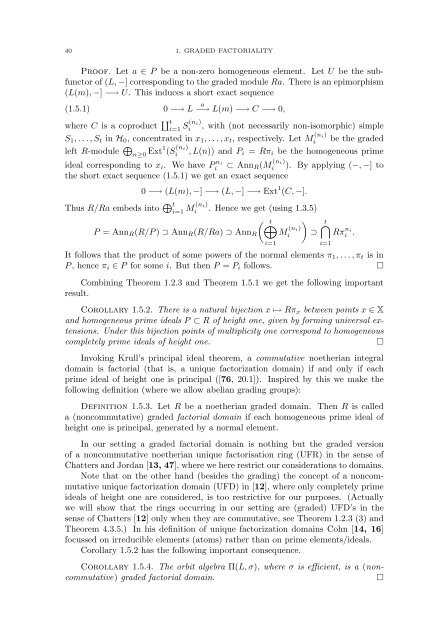MEMOIRS
MEMOIRS
MEMOIRS
- No tags were found...
Create successful ePaper yourself
Turn your PDF publications into a flip-book with our unique Google optimized e-Paper software.
40 1. GRADED FACTORIALITYProof. Let a ∈ P be a non-zero homogeneous element. Let U be the subfunctorof (L, −] corresponding to the graded module Ra. There is an epimorphism(L(m), −] −→ U. This induces a short exact sequence(1.5.1) 0 −→ L −→ aL(m) −→ C −→ 0,where C is a coproduct ∐ t, with (not necessarily non-isomorphic) simplei=1 S(n i)ibe the gradedleft R-module ⊕ n≥0 Ext1 (S (n i)i ,L(n)) and P i = Rπ i be the homogeneous primeideal corresponding to x i . We have P n ii ⊂ Ann R (M (n i)i ). By applying (−, −] tothe short exact sequence (1.5.1) we get an exact sequence0 −→ (L(m), −] −→ (L, −] −→ Ext 1 (C, −].S 1 ,...,S t in H 0 , concentrated in x 1 ,...,x t , respectively. Let M (n i)iThus R/Ra embeds into ⊕ ti=1 M (n i)i . Hence we get (using 1.3.5))P =Ann R (R/P ) ⊃ Ann R (R/Ra) ⊃ Ann R( t⊕i=1M (n i)i⊃t⋂i=1Rπ n ii .It follows that the product of some powers of the normal elements π 1 ,...,π t is inP , hence π i ∈ P for some i. ButthenP = P i follows.□Combining Theorem 1.2.3 and Theorem 1.5.1 we get the following importantresult.Corollary 1.5.2. There is a natural bijection x ↦→ Rπ x between points x ∈ Xand homogeneous prime ideals P ⊂ R of height one, given by forming universal extensions.Under this bijection points of multiplicity one correspond to homogeneouscompletely prime ideals of height one.□Invoking Krull’s principal ideal theorem, a commutative noetherian integraldomain is factorial (that is, a unique factorization domain) if and only if eachprime ideal of height one is principal ([76, 20.1]). Inspired by this we make thefollowing definition (where we allow abelian grading groups):Definition 1.5.3. Let R be a noetherian graded domain. Then R is calleda (noncommutative) graded factorial domain if each homogeneous prime ideal ofheight one is principal, generated by a normal element.In our setting a graded factorial domain is nothing but the graded versionof a noncommutative noetherian unique factorisation ring (UFR) in the sense ofChatters and Jordan [13, 47], where we here restrict our considerations to domains.Note that on the other hand (besides the grading) the concept of a noncommutativeunique factorization domain (UFD) in [12], where only completely primeideals of height one are considered, is too restrictive for our purposes. (Actuallywe will show that the rings occurring in our setting are (graded) UFD’s in thesense of Chatters [12] only when they are commutative, see Theorem 1.2.3 (3) andTheorem 4.3.5.) In his definition of unique factorization domains Cohn [14, 16]focussed on irreducible elements (atoms) rather than on prime elements/ideals.Corollary 1.5.2 has the following important consequence.Corollary 1.5.4. The orbit algebra Π(L, σ), whereσ is efficient, is a (noncommutative)graded factorial domain.□
















